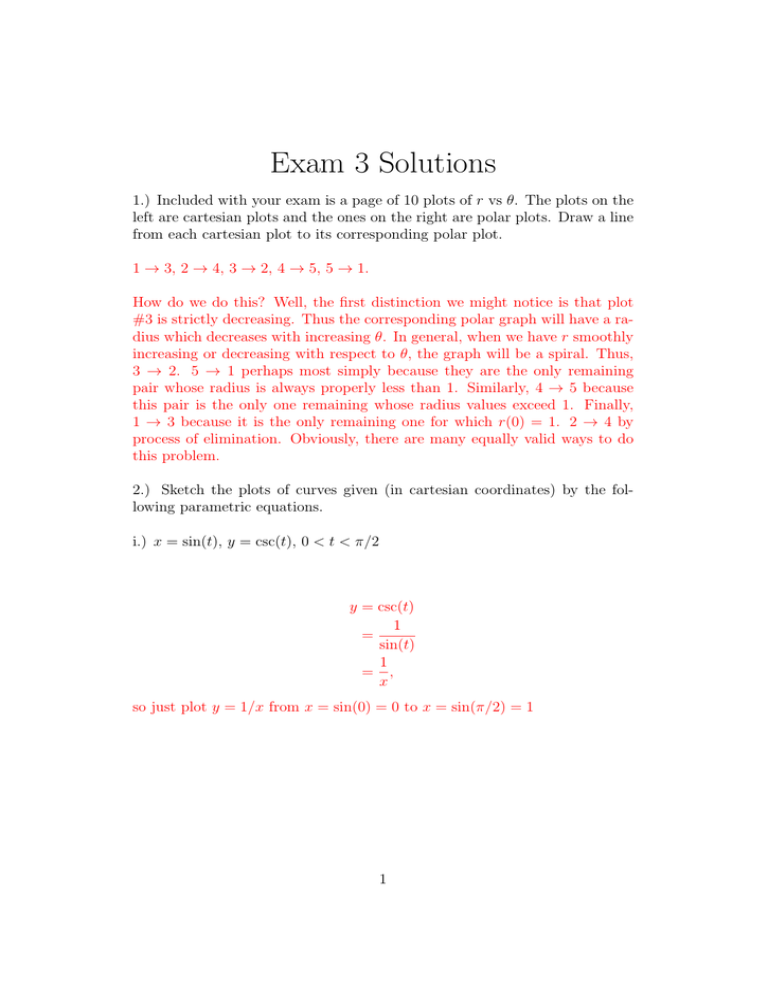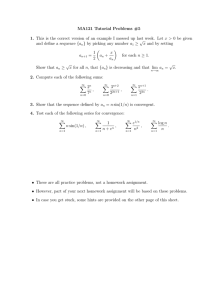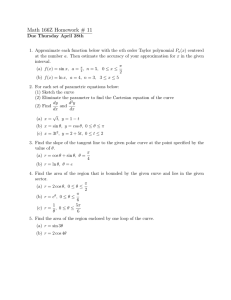Exam 3 Solutions
advertisement

Exam 3 Solutions 1.) Included with your exam is a page of 10 plots of r vs θ. The plots on the left are cartesian plots and the ones on the right are polar plots. Draw a line from each cartesian plot to its corresponding polar plot. 1 → 3, 2 → 4, 3 → 2, 4 → 5, 5 → 1. How do we do this? Well, the first distinction we might notice is that plot #3 is strictly decreasing. Thus the corresponding polar graph will have a radius which decreases with increasing θ. In general, when we have r smoothly increasing or decreasing with respect to θ, the graph will be a spiral. Thus, 3 → 2. 5 → 1 perhaps most simply because they are the only remaining pair whose radius is always properly less than 1. Similarly, 4 → 5 because this pair is the only one remaining whose radius values exceed 1. Finally, 1 → 3 because it is the only remaining one for which r(0) = 1. 2 → 4 by process of elimination. Obviously, there are many equally valid ways to do this problem. 2.) Sketch the plots of curves given (in cartesian coordinates) by the following parametric equations. i.) x = sin(t), y = csc(t), 0 < t < π/2 y = csc(t) 1 = sin(t) 1 = , x so just plot y = 1/x from x = sin(0) = 0 to x = sin(π/2) = 1 1 ii.) x = 4 cos(t), y = 5 sin(t), 0 < t < 2π 1 = cos2 (t) + sin2 (t) x 2 y 2 = + 4 5 so the curve is an ellipse with axes 4 and 5. 2 iii.) x = t2 + 2t + 1, y = 1 + et+1 , 0 < t < 10 y = 1 + et+1 √ 2 = 1 + e (t+1) since t > 0 √ =1+e √ =1+e t2 +2t+1 x . 3.) For this problem, let c be a real number, and let f be a continuously differentiable real-valued function with f 0 (c) 6= 0. Also, let g be a real valued function, and let x = f (t), y = g(t) for t in some open interval containing c. i.) Show that there is an open interval (a, b) containing c for which f 0 (c) 6= 0 f 0 (t) 6= 0. Hint: Since f 0 is continuous at c we know that for every positive number , there is an open interval (a, b) containing c such that for all t in (a, b), f 0 (t) − < f 0 (c) < f 0 (t) + . Since f 0 (c) 6= 0, we know that there is a positive number such that < |f 0 (c)|. That way, any real number r such that r − < f 0 (c) < r + will not be equal to 0 either. But we know from the − δ definition of the limit that we can choose an open interval (a, b) containing c such that for all t in (a, b), f 0 (t) − < f 0 (c) < f 0 (t) + . Thus, f 0 (t) 6= 0 for t in (a, b). 3 ii.) Use (i) to show that f is strictly increasing or strictly decreasing on the interval (a, b). Since f 0 6= 0 on (a, b) and is continuous, it must always either be strictly greater than or strictly less than 0 on this interval. Thus, f is either increasing or decreasing iii.) Show that there is a function F such that y = F (x) for f (a) < x < f (b). Hint: Show that f −1 exists. Since f is strictly increasing or decreasing on (a, b), it is 1-1. In other words, for any t1 6= t2 in (a, b), f (t1 ) 6= f (t2 ). To show this, suppose we have two distinct numbers in (a, b). Call the lesser one t1 and the greater one t2 . Then if f is increasing, f (t1 ) < f (t2 ) and if it is decreasing, f (t1 ) > f (t2 ). Either way, f (t1 ) 6= f (t2 ). The range of f on the interval (a, b) is (f (a), f (b)) because f is increasing or decreasing continuously from f (a) to f (b). Thus f −1 exists on the domain (f (a), f (b)). But since x = f (t), t = f −1 (x), so y = g (f −1 (x)). 4 4.) Consider the curve given in polar coordinates by r = sin(θ)e−θ , 0 < θ < π. Find the point along the curve which is farthest from the origin. dr = 0 We want to maximize r with respect to θ, so we will find where dθ dr for 0 < θ < π. Now, dθ = e−θ (cos(θ) − sin(θ)), so we must find θ such that cos(θ) = sin(θ), and the only θ between 0 and π for which this is true is θ = π/4. Thus, the point we are seeking is (θ, r) = (π/4, sin(π/4)e−π/4 ). 5.) Consider the curve given in cartesian coordinates by the parametric equations x = t − sin(t), y = 1 − cos(t), 0 < t < 2π. See example 10.2.3 in your book. i.) Sketch the curve. 5 ii.)Find the area between the curve and the x-axis. 6 2 r 1 1.0 0.5 Θ 1 2 3 4 5 0.5 -1.0 -0.5 6 1.0 -0.5 -1 -1.0 -2 1.0 r 1.4 1.2 0.5 1.0 0.8 0.6 -0.6-0.4-0.2 0.2 0.4 0.6 0.4 0.2 0.0 -0.5 Θ 0 1 2 3 4 5 6 -1.0 r 100 1.0 80 0.8 60 0.6 0.4 40 0.2 20 -1.0 0.5 -0.5 1.0 Θ 2 4 6 8 10 1.0 r 0.5 1.5 1.0 0.5 Θ 1 2 3 4 5 -1.0 0.5 -0.5 6 1.0 -0.5 -1.0 -0.5 -1.5 -1.0 60 r 40 1.4 1.2 20 1.0 7 0.8 0.6 -80 -60 -40 20 -20 0.4 -20 0.2 0.0 Θ 0 20 40 60 80 100 -40 40





